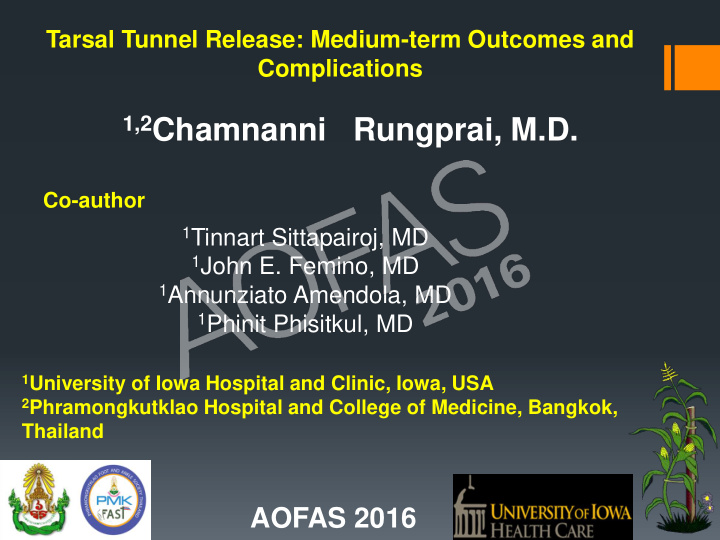



Tarsal Tunnel Release: Medium-term Outcomes and Complications 1,2 Chamnanni Rungprai, M.D. Co-author 1 Tinnart Sittapairoj, MD 1 John E. Femino, MD 1 Annunziato Amendola, MD 1 Phinit Phisitkul, MD 1 University of Iowa Hospital and Clinic, Iowa, USA 2 Phramongkutklao Hospital and College of Medicine, Bangkok, Thailand AOFAS 2016
Disclosure The authors have no conflicts to disclose. Tarsal Tunnel Release: Medium-term Outcomes and Complications Tinnart Sittapairoj, MD John E. Femino, MD Annunziato Amendola, MD Phinit Phisitkul, MD My disclosure is in the Final AOFAS app. We have no potential conflicts with this presentation.
Introduction Tarsal tunnel release is a standard surgical treatment for patients who have tarsal tunnel syndrome and failure of conservative treatment. 1-4 However, there remains little evidence demonstrating the medium-term of functional outcomes and complications of tarsal tunnel release. 1-3 The purpose of this study was to report functional outcomes and complications of tarsal tunnel release.
Materials and methods Retrospective chart review Diagnosis bases on history with prospectively collected and physical examination. data of 79 consecutive patients with 87 feet All patients were failure of (primary surgery = 74/80 conservative treatment at least and revision surgery = 5/5) 6 weeks and the minimum who were diagnosed with follow up to be included in the tarsal tunnel syndrome and study was 12 months (mean, underwent tarsal tunnel 32.2 months; range, 12 to 80 release between 2008 and months). 2014.
Materials and methods • Statistic Analysis The primary outcome included • Mann-Whitney U-test was used to Visual Analogue Scale (VAS), compare non-parametric data and Foot Function Index (FFI, pain, Wilcoxon signed ranks test was used disability, activity limitations, and total to compare parametric data. scores), Short Form-36 (SF-36, PCS and MCS) The secondary outcomes included Operative time Time to return to daily activities, works, and sports. Complications.
Table 1 Demographic characteristics of patients who underwent tarsal tunnel release. Parameters Tarsal tunnel release Number of patients / feet 79 / 87 Age of time at surgery (years) (range) 46.2 ± 14.9 (18-75) Male : Female ratio (no. of patients) 19 : 58 BMI(Kg/m 2 ) (range) 30.7 ± 8.0 (18.3-48.6) Duration of symptom before surgery (range, 20.6 ± 23.1 months) (2-120) Duration of follow up (months) (range, 32.2 ± 18.4 months) (12-80) Side (Left/Right) 41 / 46 Operative time (minutes) (primary) (n=82) 36.1 ± 15.6 (19-60) Operative time (minutes) (revision) (n=5) 54.8 ± 15.6 (50-74) Average time to return to activity of daily 8.1 ± 2.8 living (weeks) (6-12) Average time to release to work (weeks) 9.5 ± 5.0 (6-20)
TABLE 2 Comparison between pre- and post-operative functional outcomes in patients with tarsal tunnel release. Tarsal tunnel release Functional Outcomes (N = 87 feet) *Pre / Post-operative Visual Analog Scale (range) 7.6 ± 2.0 / 2.0 ± 2.2 (no.) (n=84) (p = 0.001)** *SF-36 Score: at final follow up (points) PCS: pre / post-operative (no.) 33.2 ± 9.7 / 40.2 ± 8.8 (n=52) (p = 0.001)** MCS: pre / post-operative (no.) 47.7 ± 11.8 / 49.7 ± 14.0 (n=52) (p = 0.005)** *Foot Function Index (FFI): pre / post-operative at final follow up Pain: pre / post-operative (no.) 63.0 ± 12.8 / 36.0 ± 9.4 (n=44) (p=0.001)** Disability: pre / post-operative (no.) 61.9 ± 8.5 / 35.0 ± 6.1 (n=45) (p=0.001)** Activity limitation: pre / post-operative (no.) 72.5 ± 10.7 / 34.9 ± 12.4 (n=44) (p=0.001)** Total score: pre / post-operative (no.) 65.8 ± 6.9 / 35.3 ± 6.4 (n=44) (p=0.001)** *Wilcoxon signed-ranks test was used to compare all pre and post-operative functional results (VAS, SF-36 (PCS and MCS), and FFI (Pain, Disability, Activity limitation, and Total score)) and it is statistically significant difference with p-value less than 0.05(**).
TABLE 3 Comparisons in patients with tarsal tunnel release. Complications Tarsal tunnel release (total = 87 feet) Superficial wound infection 6 (6.9%) Deep wound infection 0 (0.0%) Painful scar 13 (14.9%) CRPS 2/87 feet (2.3%) 2 (2.3%) Paresthesia on the foot 18 (20.7%). Tinel sign positive 9 (10.3%)
Discussion The tarsal tunnel release can significantly improve functional outcome and pain relief in patients with tarsal tunnel syndrome; however, some of patients have some degrees of persistent pain after the surgery. The patient required counseling for the complications before the surgery and the common complications include painful scar, numbness on the plantar and medial side of the foot, and sensitive on the skin at the incision ; however, these complications were improved over the time.
Discussion Limitations Strengths Retrospective design with no Consecutive case collection. randomization was used in the methods. Systematically collected outcome data using validated assessment Some patients were lost to follow- methods. up and some did not response to the questionnaires, resulting in All surgeries were performed by the approximately fifty percent of same group of fellowship-trained patients available to be analyzed at orthopaedic foot and ankle final follow-up. surgeons.
Conclusion Tarsal tunnel release demonstrated significant improvement of functional outcomes and pain relief in medium-term follow- up as measured with SF-36, FFI, and VAS. Revision surgery demonstrated less favorable outcomes while pre-operative Tinel test and duration of symptom more than 12 months did not affect the outcome. This procedure was effective and feasible for tarsal tunnel syndrome with minor complications.
Reference: 1. Gondring WH, Shields B, Wenger S. An outcomes analysis of surgical treatment of tarsal tunnel syndrome.Foot Ankle Int. 2003 Jul;24(7):545-50. 2. Reade BM, Longo DC, Keller MC. Tarsal tunnel syndrome. Clin Podiatr Med Surg. 2001 Jul;18(3):395-408. Review. 3. Bailie DS, Kelikian AS. Tarsal tunnel syndrome: diagnosis, surgical technique, and functional outcome. Foot Ankle Int. 1998 Feb;19(2):65-72. Review. 4. Sammarco GJ, Conti SF. Tarsal tunnel syndrome caused by an anomalous muscle. J Bone Joint Surg Am. 1994 Sep;76(9):1308-14. Thank You for your attention!
Recommend
More recommend